Western Sydney University: Sound Attenuating Window Systems Report
VerifiedAdded on 2022/10/02
|10
|2832
|20
Report
AI Summary
This report, prepared for the Construction in Practice 1 module at Western Sydney University, examines sound attenuating window systems for residential buildings. It delves into the problem of noise pollution and its impact on dwellings, particularly focusing on windows as major sound conductors. The report explores three primary solutions: retrofitting or replacing existing windows with sound control windows, installing window plugs, and applying acoustic sound dampening plastic film. Each method is analyzed in detail, including its advantages, disadvantages, and cost considerations. The report provides a comparative analysis of these options, offering insights into their effectiveness in reducing noise transmission and improving the acoustic environment of residential spaces. The discussion includes considerations of Sound Transmission Class (STC) and Outdoor Indoor Transmission Class (OITC) ratings, and explores the benefits of each approach, such as improved comfort, energy savings, and privacy. The report concludes by emphasizing the significance of employing these options to mitigate noise pollution and improve the quality of life in residential settings, suggesting that a combination of methods might be the most effective approach.

CONSTRUCTION MANAGEMENT 1
Construction Management
Name of Student
Institution Affiliation
Construction Management
Name of Student
Institution Affiliation
Paraphrase This Document
Need a fresh take? Get an instant paraphrase of this document with our AI Paraphraser
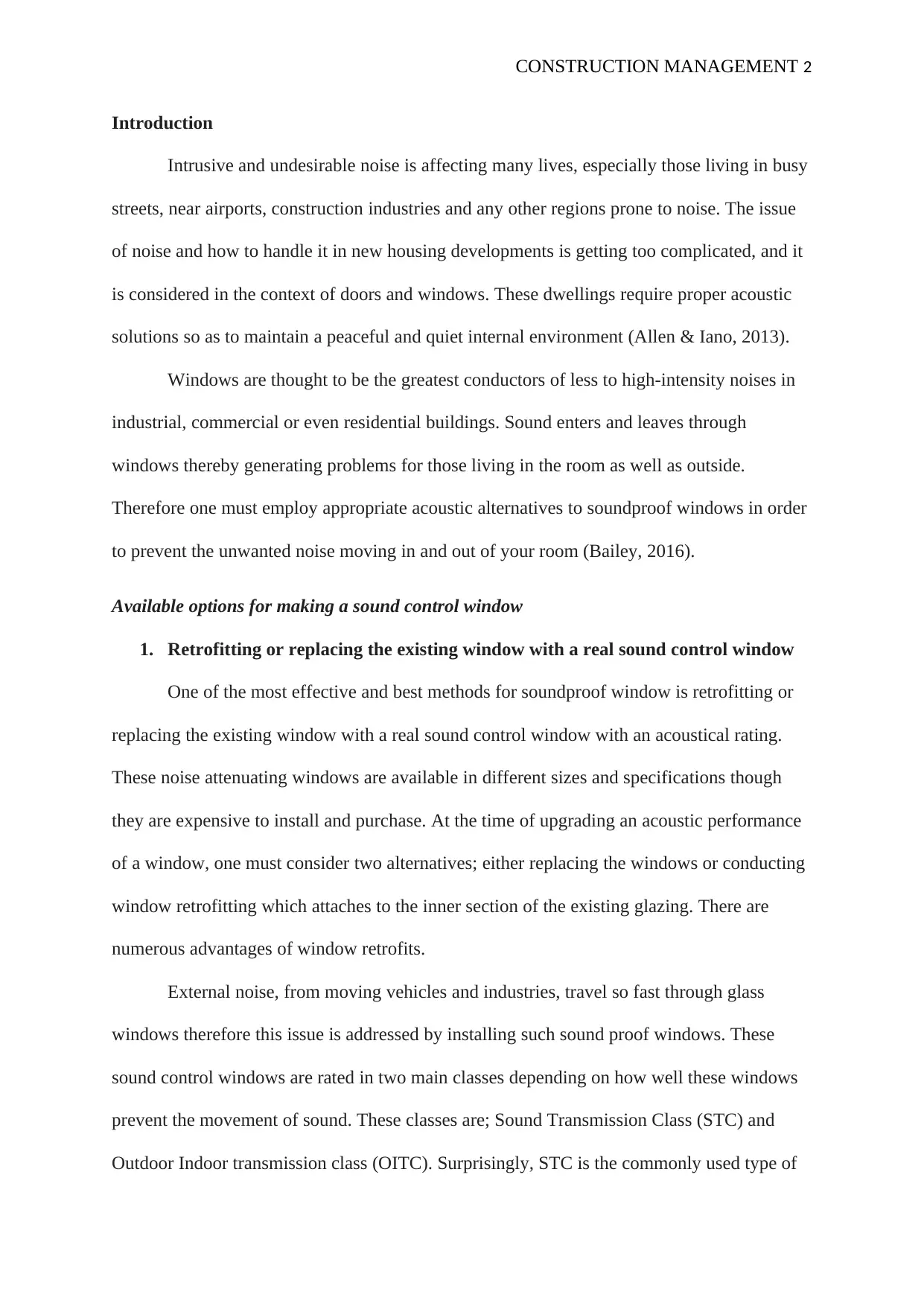
CONSTRUCTION MANAGEMENT 2
Introduction
Intrusive and undesirable noise is affecting many lives, especially those living in busy
streets, near airports, construction industries and any other regions prone to noise. The issue
of noise and how to handle it in new housing developments is getting too complicated, and it
is considered in the context of doors and windows. These dwellings require proper acoustic
solutions so as to maintain a peaceful and quiet internal environment (Allen & Iano, 2013).
Windows are thought to be the greatest conductors of less to high-intensity noises in
industrial, commercial or even residential buildings. Sound enters and leaves through
windows thereby generating problems for those living in the room as well as outside.
Therefore one must employ appropriate acoustic alternatives to soundproof windows in order
to prevent the unwanted noise moving in and out of your room (Bailey, 2016).
Available options for making a sound control window
1. Retrofitting or replacing the existing window with a real sound control window
One of the most effective and best methods for soundproof window is retrofitting or
replacing the existing window with a real sound control window with an acoustical rating.
These noise attenuating windows are available in different sizes and specifications though
they are expensive to install and purchase. At the time of upgrading an acoustic performance
of a window, one must consider two alternatives; either replacing the windows or conducting
window retrofitting which attaches to the inner section of the existing glazing. There are
numerous advantages of window retrofits.
External noise, from moving vehicles and industries, travel so fast through glass
windows therefore this issue is addressed by installing such sound proof windows. These
sound control windows are rated in two main classes depending on how well these windows
prevent the movement of sound. These classes are; Sound Transmission Class (STC) and
Outdoor Indoor transmission class (OITC). Surprisingly, STC is the commonly used type of
Introduction
Intrusive and undesirable noise is affecting many lives, especially those living in busy
streets, near airports, construction industries and any other regions prone to noise. The issue
of noise and how to handle it in new housing developments is getting too complicated, and it
is considered in the context of doors and windows. These dwellings require proper acoustic
solutions so as to maintain a peaceful and quiet internal environment (Allen & Iano, 2013).
Windows are thought to be the greatest conductors of less to high-intensity noises in
industrial, commercial or even residential buildings. Sound enters and leaves through
windows thereby generating problems for those living in the room as well as outside.
Therefore one must employ appropriate acoustic alternatives to soundproof windows in order
to prevent the unwanted noise moving in and out of your room (Bailey, 2016).
Available options for making a sound control window
1. Retrofitting or replacing the existing window with a real sound control window
One of the most effective and best methods for soundproof window is retrofitting or
replacing the existing window with a real sound control window with an acoustical rating.
These noise attenuating windows are available in different sizes and specifications though
they are expensive to install and purchase. At the time of upgrading an acoustic performance
of a window, one must consider two alternatives; either replacing the windows or conducting
window retrofitting which attaches to the inner section of the existing glazing. There are
numerous advantages of window retrofits.
External noise, from moving vehicles and industries, travel so fast through glass
windows therefore this issue is addressed by installing such sound proof windows. These
sound control windows are rated in two main classes depending on how well these windows
prevent the movement of sound. These classes are; Sound Transmission Class (STC) and
Outdoor Indoor transmission class (OITC). Surprisingly, STC is the commonly used type of
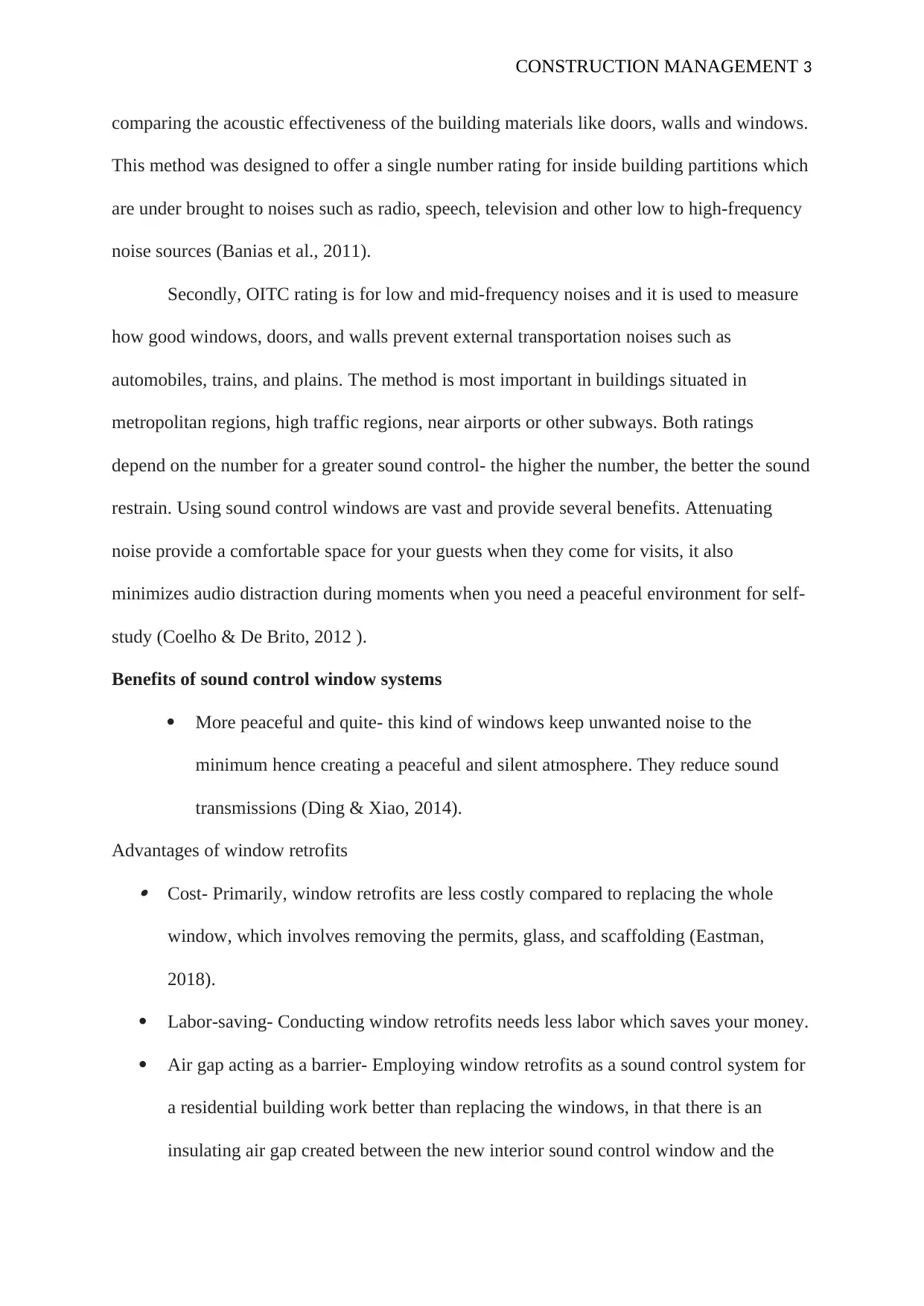
CONSTRUCTION MANAGEMENT 3
comparing the acoustic effectiveness of the building materials like doors, walls and windows.
This method was designed to offer a single number rating for inside building partitions which
are under brought to noises such as radio, speech, television and other low to high-frequency
noise sources (Banias et al., 2011).
Secondly, OITC rating is for low and mid-frequency noises and it is used to measure
how good windows, doors, and walls prevent external transportation noises such as
automobiles, trains, and plains. The method is most important in buildings situated in
metropolitan regions, high traffic regions, near airports or other subways. Both ratings
depend on the number for a greater sound control- the higher the number, the better the sound
restrain. Using sound control windows are vast and provide several benefits. Attenuating
noise provide a comfortable space for your guests when they come for visits, it also
minimizes audio distraction during moments when you need a peaceful environment for self-
study (Coelho & De Brito, 2012 ).
Benefits of sound control window systems
More peaceful and quite- this kind of windows keep unwanted noise to the
minimum hence creating a peaceful and silent atmosphere. They reduce sound
transmissions (Ding & Xiao, 2014).
Advantages of window retrofits Cost- Primarily, window retrofits are less costly compared to replacing the whole
window, which involves removing the permits, glass, and scaffolding (Eastman,
2018).
Labor-saving- Conducting window retrofits needs less labor which saves your money.
Air gap acting as a barrier- Employing window retrofits as a sound control system for
a residential building work better than replacing the windows, in that there is an
insulating air gap created between the new interior sound control window and the
comparing the acoustic effectiveness of the building materials like doors, walls and windows.
This method was designed to offer a single number rating for inside building partitions which
are under brought to noises such as radio, speech, television and other low to high-frequency
noise sources (Banias et al., 2011).
Secondly, OITC rating is for low and mid-frequency noises and it is used to measure
how good windows, doors, and walls prevent external transportation noises such as
automobiles, trains, and plains. The method is most important in buildings situated in
metropolitan regions, high traffic regions, near airports or other subways. Both ratings
depend on the number for a greater sound control- the higher the number, the better the sound
restrain. Using sound control windows are vast and provide several benefits. Attenuating
noise provide a comfortable space for your guests when they come for visits, it also
minimizes audio distraction during moments when you need a peaceful environment for self-
study (Coelho & De Brito, 2012 ).
Benefits of sound control window systems
More peaceful and quite- this kind of windows keep unwanted noise to the
minimum hence creating a peaceful and silent atmosphere. They reduce sound
transmissions (Ding & Xiao, 2014).
Advantages of window retrofits Cost- Primarily, window retrofits are less costly compared to replacing the whole
window, which involves removing the permits, glass, and scaffolding (Eastman,
2018).
Labor-saving- Conducting window retrofits needs less labor which saves your money.
Air gap acting as a barrier- Employing window retrofits as a sound control system for
a residential building work better than replacing the windows, in that there is an
insulating air gap created between the new interior sound control window and the
⊘ This is a preview!⊘
Do you want full access?
Subscribe today to unlock all pages.

Trusted by 1+ million students worldwide
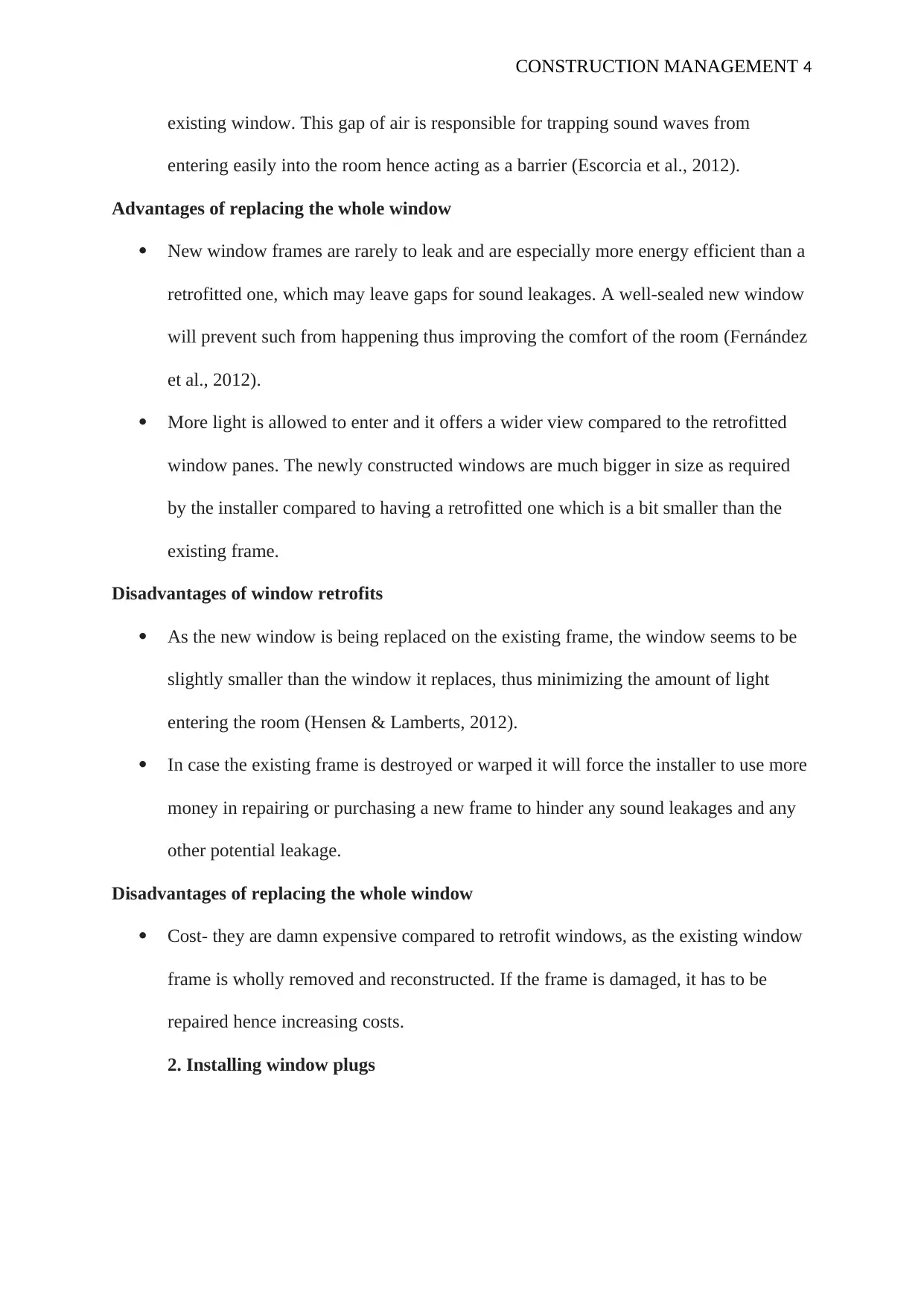
CONSTRUCTION MANAGEMENT 4
existing window. This gap of air is responsible for trapping sound waves from
entering easily into the room hence acting as a barrier (Escorcia et al., 2012).
Advantages of replacing the whole window
New window frames are rarely to leak and are especially more energy efficient than a
retrofitted one, which may leave gaps for sound leakages. A well-sealed new window
will prevent such from happening thus improving the comfort of the room (Fernández
et al., 2012).
More light is allowed to enter and it offers a wider view compared to the retrofitted
window panes. The newly constructed windows are much bigger in size as required
by the installer compared to having a retrofitted one which is a bit smaller than the
existing frame.
Disadvantages of window retrofits
As the new window is being replaced on the existing frame, the window seems to be
slightly smaller than the window it replaces, thus minimizing the amount of light
entering the room (Hensen & Lamberts, 2012).
In case the existing frame is destroyed or warped it will force the installer to use more
money in repairing or purchasing a new frame to hinder any sound leakages and any
other potential leakage.
Disadvantages of replacing the whole window
Cost- they are damn expensive compared to retrofit windows, as the existing window
frame is wholly removed and reconstructed. If the frame is damaged, it has to be
repaired hence increasing costs.
2. Installing window plugs
existing window. This gap of air is responsible for trapping sound waves from
entering easily into the room hence acting as a barrier (Escorcia et al., 2012).
Advantages of replacing the whole window
New window frames are rarely to leak and are especially more energy efficient than a
retrofitted one, which may leave gaps for sound leakages. A well-sealed new window
will prevent such from happening thus improving the comfort of the room (Fernández
et al., 2012).
More light is allowed to enter and it offers a wider view compared to the retrofitted
window panes. The newly constructed windows are much bigger in size as required
by the installer compared to having a retrofitted one which is a bit smaller than the
existing frame.
Disadvantages of window retrofits
As the new window is being replaced on the existing frame, the window seems to be
slightly smaller than the window it replaces, thus minimizing the amount of light
entering the room (Hensen & Lamberts, 2012).
In case the existing frame is destroyed or warped it will force the installer to use more
money in repairing or purchasing a new frame to hinder any sound leakages and any
other potential leakage.
Disadvantages of replacing the whole window
Cost- they are damn expensive compared to retrofit windows, as the existing window
frame is wholly removed and reconstructed. If the frame is damaged, it has to be
repaired hence increasing costs.
2. Installing window plugs
Paraphrase This Document
Need a fresh take? Get an instant paraphrase of this document with our AI Paraphraser
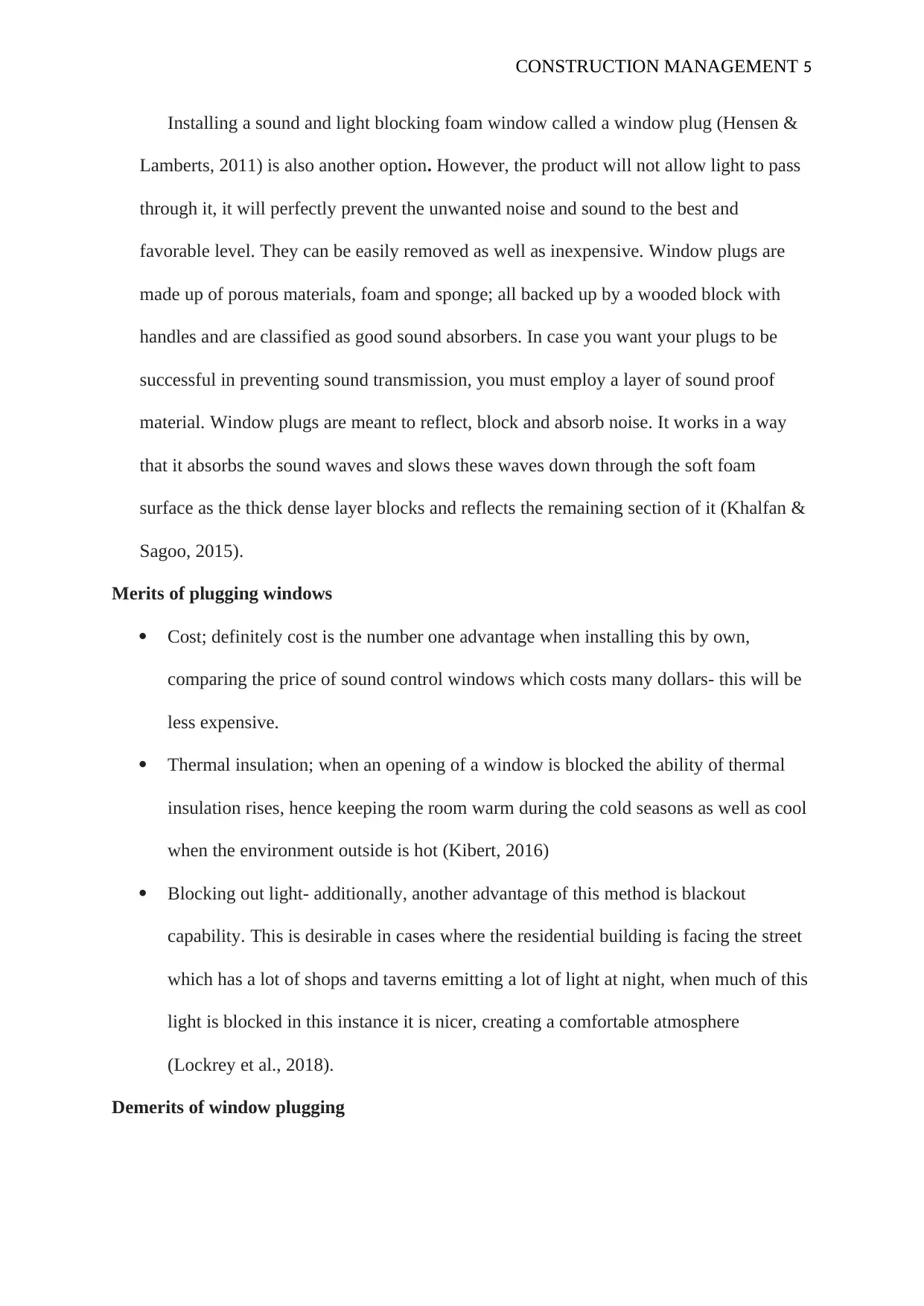
CONSTRUCTION MANAGEMENT 5
Installing a sound and light blocking foam window called a window plug (Hensen &
Lamberts, 2011) is also another option. However, the product will not allow light to pass
through it, it will perfectly prevent the unwanted noise and sound to the best and
favorable level. They can be easily removed as well as inexpensive. Window plugs are
made up of porous materials, foam and sponge; all backed up by a wooded block with
handles and are classified as good sound absorbers. In case you want your plugs to be
successful in preventing sound transmission, you must employ a layer of sound proof
material. Window plugs are meant to reflect, block and absorb noise. It works in a way
that it absorbs the sound waves and slows these waves down through the soft foam
surface as the thick dense layer blocks and reflects the remaining section of it (Khalfan &
Sagoo, 2015).
Merits of plugging windows
Cost; definitely cost is the number one advantage when installing this by own,
comparing the price of sound control windows which costs many dollars- this will be
less expensive.
Thermal insulation; when an opening of a window is blocked the ability of thermal
insulation rises, hence keeping the room warm during the cold seasons as well as cool
when the environment outside is hot (Kibert, 2016)
Blocking out light- additionally, another advantage of this method is blackout
capability. This is desirable in cases where the residential building is facing the street
which has a lot of shops and taverns emitting a lot of light at night, when much of this
light is blocked in this instance it is nicer, creating a comfortable atmosphere
(Lockrey et al., 2018).
Demerits of window plugging
Installing a sound and light blocking foam window called a window plug (Hensen &
Lamberts, 2011) is also another option. However, the product will not allow light to pass
through it, it will perfectly prevent the unwanted noise and sound to the best and
favorable level. They can be easily removed as well as inexpensive. Window plugs are
made up of porous materials, foam and sponge; all backed up by a wooded block with
handles and are classified as good sound absorbers. In case you want your plugs to be
successful in preventing sound transmission, you must employ a layer of sound proof
material. Window plugs are meant to reflect, block and absorb noise. It works in a way
that it absorbs the sound waves and slows these waves down through the soft foam
surface as the thick dense layer blocks and reflects the remaining section of it (Khalfan &
Sagoo, 2015).
Merits of plugging windows
Cost; definitely cost is the number one advantage when installing this by own,
comparing the price of sound control windows which costs many dollars- this will be
less expensive.
Thermal insulation; when an opening of a window is blocked the ability of thermal
insulation rises, hence keeping the room warm during the cold seasons as well as cool
when the environment outside is hot (Kibert, 2016)
Blocking out light- additionally, another advantage of this method is blackout
capability. This is desirable in cases where the residential building is facing the street
which has a lot of shops and taverns emitting a lot of light at night, when much of this
light is blocked in this instance it is nicer, creating a comfortable atmosphere
(Lockrey et al., 2018).
Demerits of window plugging
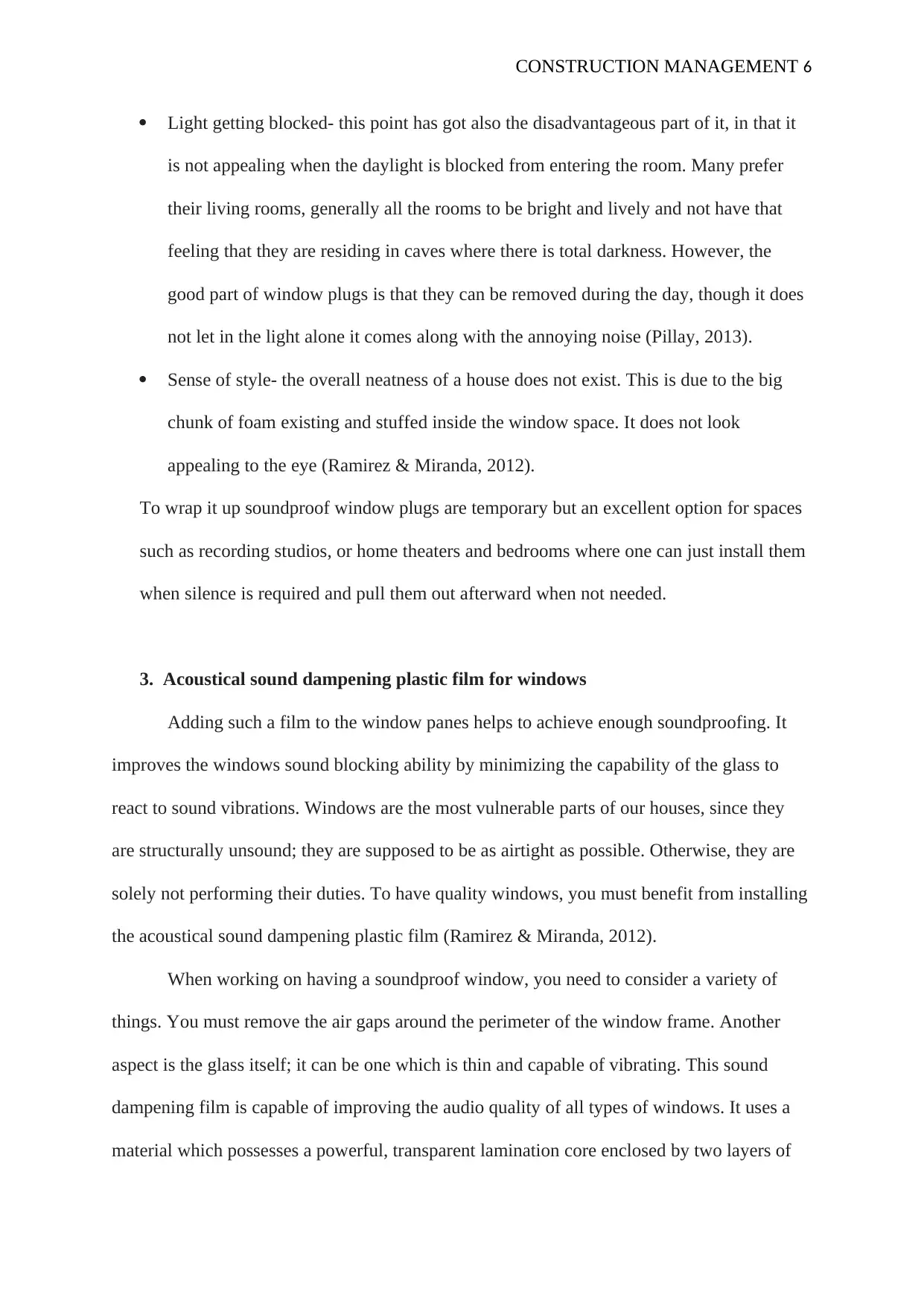
CONSTRUCTION MANAGEMENT 6
Light getting blocked- this point has got also the disadvantageous part of it, in that it
is not appealing when the daylight is blocked from entering the room. Many prefer
their living rooms, generally all the rooms to be bright and lively and not have that
feeling that they are residing in caves where there is total darkness. However, the
good part of window plugs is that they can be removed during the day, though it does
not let in the light alone it comes along with the annoying noise (Pillay, 2013).
Sense of style- the overall neatness of a house does not exist. This is due to the big
chunk of foam existing and stuffed inside the window space. It does not look
appealing to the eye (Ramirez & Miranda, 2012).
To wrap it up soundproof window plugs are temporary but an excellent option for spaces
such as recording studios, or home theaters and bedrooms where one can just install them
when silence is required and pull them out afterward when not needed.
3. Acoustical sound dampening plastic film for windows
Adding such a film to the window panes helps to achieve enough soundproofing. It
improves the windows sound blocking ability by minimizing the capability of the glass to
react to sound vibrations. Windows are the most vulnerable parts of our houses, since they
are structurally unsound; they are supposed to be as airtight as possible. Otherwise, they are
solely not performing their duties. To have quality windows, you must benefit from installing
the acoustical sound dampening plastic film (Ramirez & Miranda, 2012).
When working on having a soundproof window, you need to consider a variety of
things. You must remove the air gaps around the perimeter of the window frame. Another
aspect is the glass itself; it can be one which is thin and capable of vibrating. This sound
dampening film is capable of improving the audio quality of all types of windows. It uses a
material which possesses a powerful, transparent lamination core enclosed by two layers of
Light getting blocked- this point has got also the disadvantageous part of it, in that it
is not appealing when the daylight is blocked from entering the room. Many prefer
their living rooms, generally all the rooms to be bright and lively and not have that
feeling that they are residing in caves where there is total darkness. However, the
good part of window plugs is that they can be removed during the day, though it does
not let in the light alone it comes along with the annoying noise (Pillay, 2013).
Sense of style- the overall neatness of a house does not exist. This is due to the big
chunk of foam existing and stuffed inside the window space. It does not look
appealing to the eye (Ramirez & Miranda, 2012).
To wrap it up soundproof window plugs are temporary but an excellent option for spaces
such as recording studios, or home theaters and bedrooms where one can just install them
when silence is required and pull them out afterward when not needed.
3. Acoustical sound dampening plastic film for windows
Adding such a film to the window panes helps to achieve enough soundproofing. It
improves the windows sound blocking ability by minimizing the capability of the glass to
react to sound vibrations. Windows are the most vulnerable parts of our houses, since they
are structurally unsound; they are supposed to be as airtight as possible. Otherwise, they are
solely not performing their duties. To have quality windows, you must benefit from installing
the acoustical sound dampening plastic film (Ramirez & Miranda, 2012).
When working on having a soundproof window, you need to consider a variety of
things. You must remove the air gaps around the perimeter of the window frame. Another
aspect is the glass itself; it can be one which is thin and capable of vibrating. This sound
dampening film is capable of improving the audio quality of all types of windows. It uses a
material which possesses a powerful, transparent lamination core enclosed by two layers of
⊘ This is a preview!⊘
Do you want full access?
Subscribe today to unlock all pages.

Trusted by 1+ million students worldwide
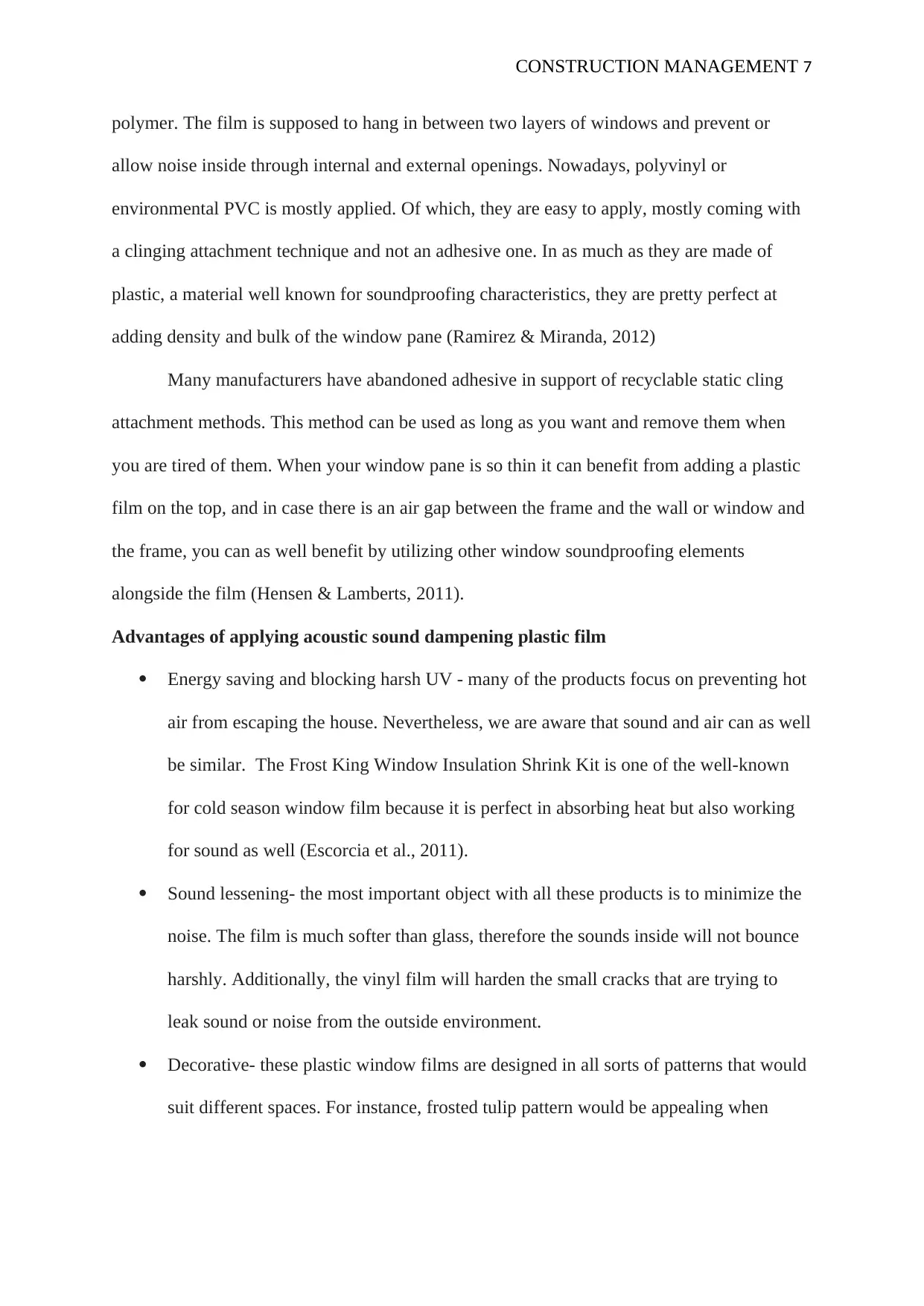
CONSTRUCTION MANAGEMENT 7
polymer. The film is supposed to hang in between two layers of windows and prevent or
allow noise inside through internal and external openings. Nowadays, polyvinyl or
environmental PVC is mostly applied. Of which, they are easy to apply, mostly coming with
a clinging attachment technique and not an adhesive one. In as much as they are made of
plastic, a material well known for soundproofing characteristics, they are pretty perfect at
adding density and bulk of the window pane (Ramirez & Miranda, 2012)
Many manufacturers have abandoned adhesive in support of recyclable static cling
attachment methods. This method can be used as long as you want and remove them when
you are tired of them. When your window pane is so thin it can benefit from adding a plastic
film on the top, and in case there is an air gap between the frame and the wall or window and
the frame, you can as well benefit by utilizing other window soundproofing elements
alongside the film (Hensen & Lamberts, 2011).
Advantages of applying acoustic sound dampening plastic film
Energy saving and blocking harsh UV - many of the products focus on preventing hot
air from escaping the house. Nevertheless, we are aware that sound and air can as well
be similar. The Frost King Window Insulation Shrink Kit is one of the well-known
for cold season window film because it is perfect in absorbing heat but also working
for sound as well (Escorcia et al., 2011).
Sound lessening- the most important object with all these products is to minimize the
noise. The film is much softer than glass, therefore the sounds inside will not bounce
harshly. Additionally, the vinyl film will harden the small cracks that are trying to
leak sound or noise from the outside environment.
Decorative- these plastic window films are designed in all sorts of patterns that would
suit different spaces. For instance, frosted tulip pattern would be appealing when
polymer. The film is supposed to hang in between two layers of windows and prevent or
allow noise inside through internal and external openings. Nowadays, polyvinyl or
environmental PVC is mostly applied. Of which, they are easy to apply, mostly coming with
a clinging attachment technique and not an adhesive one. In as much as they are made of
plastic, a material well known for soundproofing characteristics, they are pretty perfect at
adding density and bulk of the window pane (Ramirez & Miranda, 2012)
Many manufacturers have abandoned adhesive in support of recyclable static cling
attachment methods. This method can be used as long as you want and remove them when
you are tired of them. When your window pane is so thin it can benefit from adding a plastic
film on the top, and in case there is an air gap between the frame and the wall or window and
the frame, you can as well benefit by utilizing other window soundproofing elements
alongside the film (Hensen & Lamberts, 2011).
Advantages of applying acoustic sound dampening plastic film
Energy saving and blocking harsh UV - many of the products focus on preventing hot
air from escaping the house. Nevertheless, we are aware that sound and air can as well
be similar. The Frost King Window Insulation Shrink Kit is one of the well-known
for cold season window film because it is perfect in absorbing heat but also working
for sound as well (Escorcia et al., 2011).
Sound lessening- the most important object with all these products is to minimize the
noise. The film is much softer than glass, therefore the sounds inside will not bounce
harshly. Additionally, the vinyl film will harden the small cracks that are trying to
leak sound or noise from the outside environment.
Decorative- these plastic window films are designed in all sorts of patterns that would
suit different spaces. For instance, frosted tulip pattern would be appealing when
Paraphrase This Document
Need a fresh take? Get an instant paraphrase of this document with our AI Paraphraser
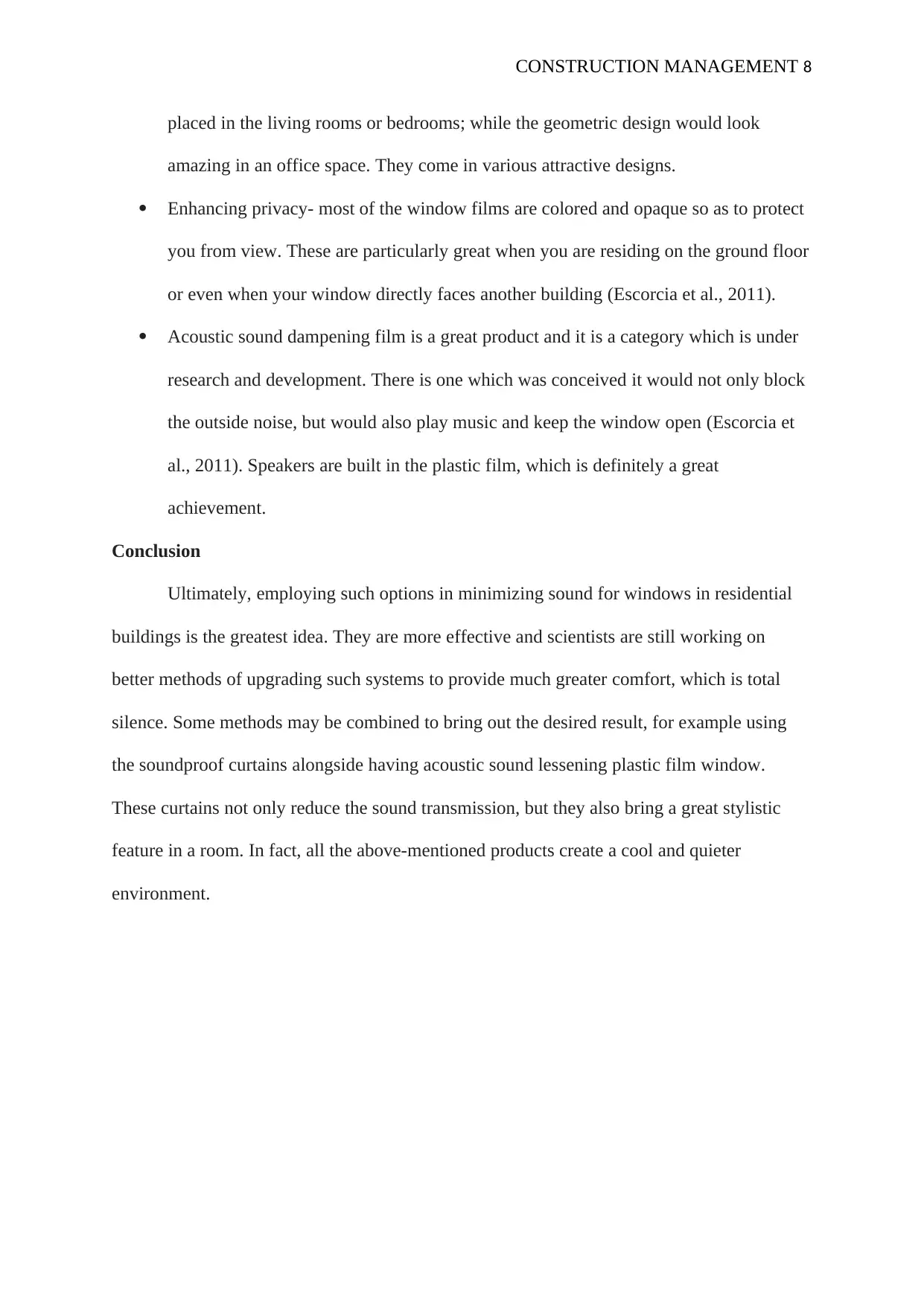
CONSTRUCTION MANAGEMENT 8
placed in the living rooms or bedrooms; while the geometric design would look
amazing in an office space. They come in various attractive designs.
Enhancing privacy- most of the window films are colored and opaque so as to protect
you from view. These are particularly great when you are residing on the ground floor
or even when your window directly faces another building (Escorcia et al., 2011).
Acoustic sound dampening film is a great product and it is a category which is under
research and development. There is one which was conceived it would not only block
the outside noise, but would also play music and keep the window open (Escorcia et
al., 2011). Speakers are built in the plastic film, which is definitely a great
achievement.
Conclusion
Ultimately, employing such options in minimizing sound for windows in residential
buildings is the greatest idea. They are more effective and scientists are still working on
better methods of upgrading such systems to provide much greater comfort, which is total
silence. Some methods may be combined to bring out the desired result, for example using
the soundproof curtains alongside having acoustic sound lessening plastic film window.
These curtains not only reduce the sound transmission, but they also bring a great stylistic
feature in a room. In fact, all the above-mentioned products create a cool and quieter
environment.
placed in the living rooms or bedrooms; while the geometric design would look
amazing in an office space. They come in various attractive designs.
Enhancing privacy- most of the window films are colored and opaque so as to protect
you from view. These are particularly great when you are residing on the ground floor
or even when your window directly faces another building (Escorcia et al., 2011).
Acoustic sound dampening film is a great product and it is a category which is under
research and development. There is one which was conceived it would not only block
the outside noise, but would also play music and keep the window open (Escorcia et
al., 2011). Speakers are built in the plastic film, which is definitely a great
achievement.
Conclusion
Ultimately, employing such options in minimizing sound for windows in residential
buildings is the greatest idea. They are more effective and scientists are still working on
better methods of upgrading such systems to provide much greater comfort, which is total
silence. Some methods may be combined to bring out the desired result, for example using
the soundproof curtains alongside having acoustic sound lessening plastic film window.
These curtains not only reduce the sound transmission, but they also bring a great stylistic
feature in a room. In fact, all the above-mentioned products create a cool and quieter
environment.
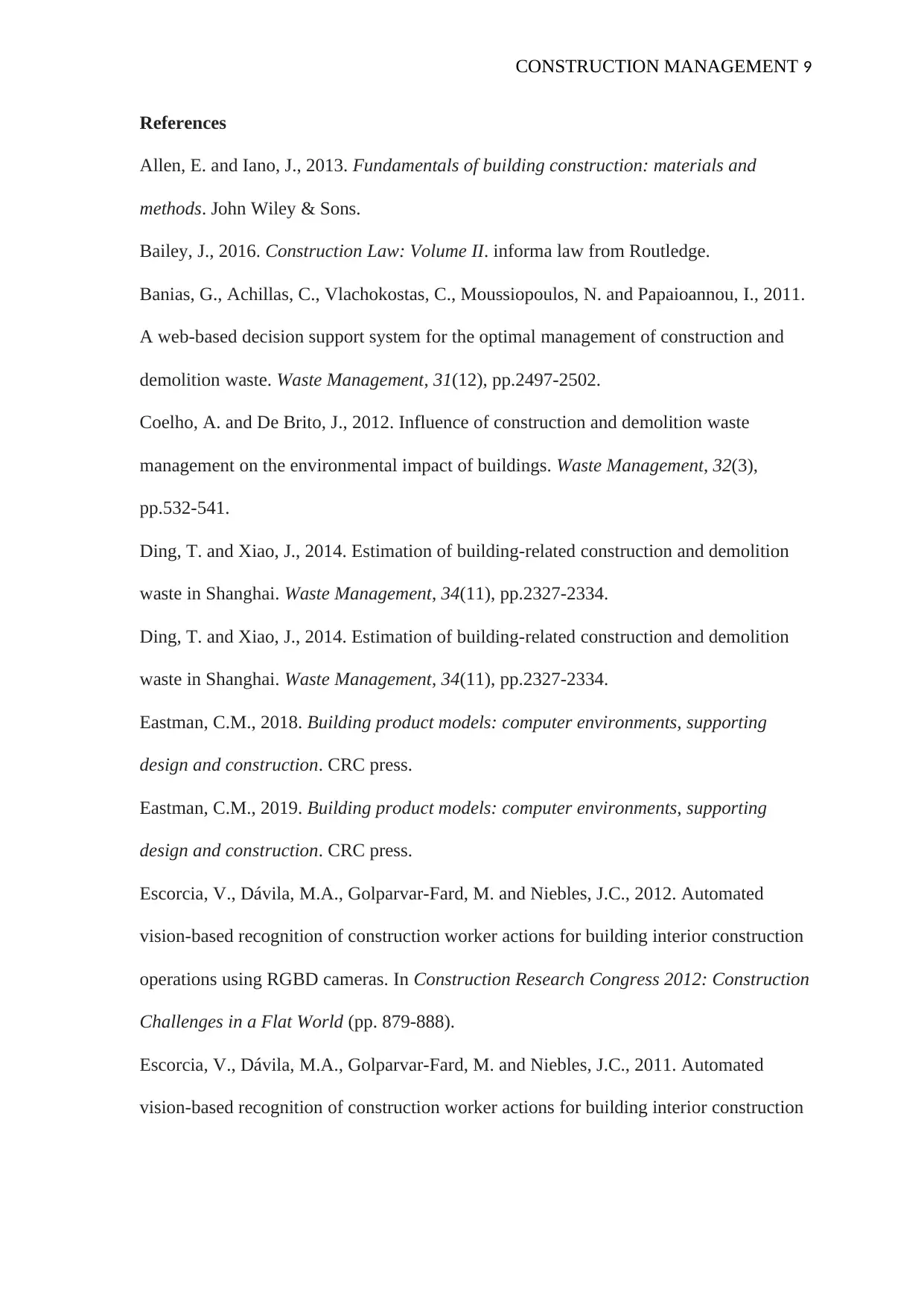
CONSTRUCTION MANAGEMENT 9
References
Allen, E. and Iano, J., 2013. Fundamentals of building construction: materials and
methods. John Wiley & Sons.
Bailey, J., 2016. Construction Law: Volume II. informa law from Routledge.
Banias, G., Achillas, C., Vlachokostas, C., Moussiopoulos, N. and Papaioannou, I., 2011.
A web-based decision support system for the optimal management of construction and
demolition waste. Waste Management, 31(12), pp.2497-2502.
Coelho, A. and De Brito, J., 2012. Influence of construction and demolition waste
management on the environmental impact of buildings. Waste Management, 32(3),
pp.532-541.
Ding, T. and Xiao, J., 2014. Estimation of building-related construction and demolition
waste in Shanghai. Waste Management, 34(11), pp.2327-2334.
Ding, T. and Xiao, J., 2014. Estimation of building-related construction and demolition
waste in Shanghai. Waste Management, 34(11), pp.2327-2334.
Eastman, C.M., 2018. Building product models: computer environments, supporting
design and construction. CRC press.
Eastman, C.M., 2019. Building product models: computer environments, supporting
design and construction. CRC press.
Escorcia, V., Dávila, M.A., Golparvar-Fard, M. and Niebles, J.C., 2012. Automated
vision-based recognition of construction worker actions for building interior construction
operations using RGBD cameras. In Construction Research Congress 2012: Construction
Challenges in a Flat World (pp. 879-888).
Escorcia, V., Dávila, M.A., Golparvar-Fard, M. and Niebles, J.C., 2011. Automated
vision-based recognition of construction worker actions for building interior construction
References
Allen, E. and Iano, J., 2013. Fundamentals of building construction: materials and
methods. John Wiley & Sons.
Bailey, J., 2016. Construction Law: Volume II. informa law from Routledge.
Banias, G., Achillas, C., Vlachokostas, C., Moussiopoulos, N. and Papaioannou, I., 2011.
A web-based decision support system for the optimal management of construction and
demolition waste. Waste Management, 31(12), pp.2497-2502.
Coelho, A. and De Brito, J., 2012. Influence of construction and demolition waste
management on the environmental impact of buildings. Waste Management, 32(3),
pp.532-541.
Ding, T. and Xiao, J., 2014. Estimation of building-related construction and demolition
waste in Shanghai. Waste Management, 34(11), pp.2327-2334.
Ding, T. and Xiao, J., 2014. Estimation of building-related construction and demolition
waste in Shanghai. Waste Management, 34(11), pp.2327-2334.
Eastman, C.M., 2018. Building product models: computer environments, supporting
design and construction. CRC press.
Eastman, C.M., 2019. Building product models: computer environments, supporting
design and construction. CRC press.
Escorcia, V., Dávila, M.A., Golparvar-Fard, M. and Niebles, J.C., 2012. Automated
vision-based recognition of construction worker actions for building interior construction
operations using RGBD cameras. In Construction Research Congress 2012: Construction
Challenges in a Flat World (pp. 879-888).
Escorcia, V., Dávila, M.A., Golparvar-Fard, M. and Niebles, J.C., 2011. Automated
vision-based recognition of construction worker actions for building interior construction
⊘ This is a preview!⊘
Do you want full access?
Subscribe today to unlock all pages.

Trusted by 1+ million students worldwide
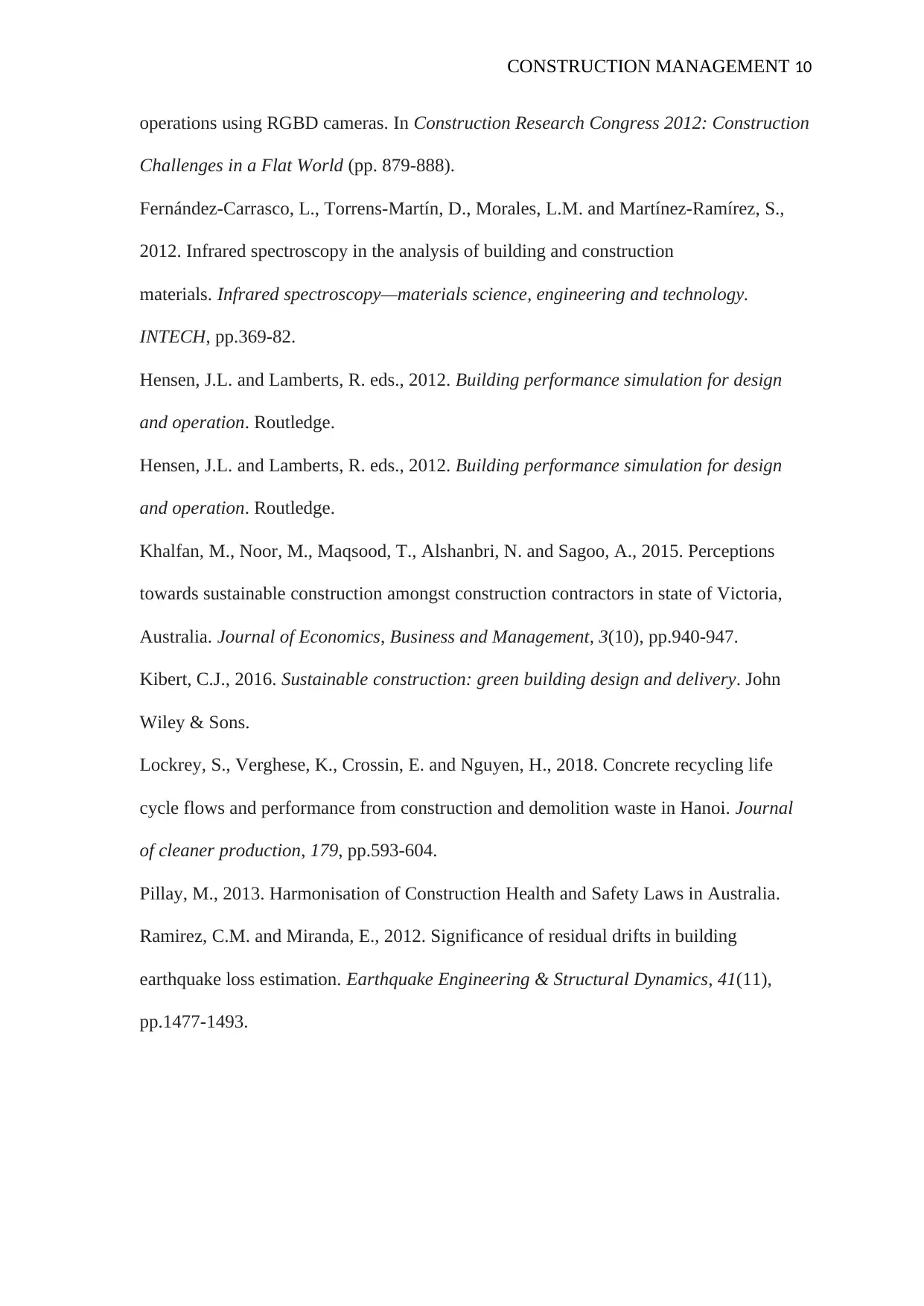
CONSTRUCTION MANAGEMENT 10
operations using RGBD cameras. In Construction Research Congress 2012: Construction
Challenges in a Flat World (pp. 879-888).
Fernández-Carrasco, L., Torrens-Martín, D., Morales, L.M. and Martínez-Ramírez, S.,
2012. Infrared spectroscopy in the analysis of building and construction
materials. Infrared spectroscopy—materials science, engineering and technology.
INTECH, pp.369-82.
Hensen, J.L. and Lamberts, R. eds., 2012. Building performance simulation for design
and operation. Routledge.
Hensen, J.L. and Lamberts, R. eds., 2012. Building performance simulation for design
and operation. Routledge.
Khalfan, M., Noor, M., Maqsood, T., Alshanbri, N. and Sagoo, A., 2015. Perceptions
towards sustainable construction amongst construction contractors in state of Victoria,
Australia. Journal of Economics, Business and Management, 3(10), pp.940-947.
Kibert, C.J., 2016. Sustainable construction: green building design and delivery. John
Wiley & Sons.
Lockrey, S., Verghese, K., Crossin, E. and Nguyen, H., 2018. Concrete recycling life
cycle flows and performance from construction and demolition waste in Hanoi. Journal
of cleaner production, 179, pp.593-604.
Pillay, M., 2013. Harmonisation of Construction Health and Safety Laws in Australia.
Ramirez, C.M. and Miranda, E., 2012. Significance of residual drifts in building
earthquake loss estimation. Earthquake Engineering & Structural Dynamics, 41(11),
pp.1477-1493.
operations using RGBD cameras. In Construction Research Congress 2012: Construction
Challenges in a Flat World (pp. 879-888).
Fernández-Carrasco, L., Torrens-Martín, D., Morales, L.M. and Martínez-Ramírez, S.,
2012. Infrared spectroscopy in the analysis of building and construction
materials. Infrared spectroscopy—materials science, engineering and technology.
INTECH, pp.369-82.
Hensen, J.L. and Lamberts, R. eds., 2012. Building performance simulation for design
and operation. Routledge.
Hensen, J.L. and Lamberts, R. eds., 2012. Building performance simulation for design
and operation. Routledge.
Khalfan, M., Noor, M., Maqsood, T., Alshanbri, N. and Sagoo, A., 2015. Perceptions
towards sustainable construction amongst construction contractors in state of Victoria,
Australia. Journal of Economics, Business and Management, 3(10), pp.940-947.
Kibert, C.J., 2016. Sustainable construction: green building design and delivery. John
Wiley & Sons.
Lockrey, S., Verghese, K., Crossin, E. and Nguyen, H., 2018. Concrete recycling life
cycle flows and performance from construction and demolition waste in Hanoi. Journal
of cleaner production, 179, pp.593-604.
Pillay, M., 2013. Harmonisation of Construction Health and Safety Laws in Australia.
Ramirez, C.M. and Miranda, E., 2012. Significance of residual drifts in building
earthquake loss estimation. Earthquake Engineering & Structural Dynamics, 41(11),
pp.1477-1493.
1 out of 10
Your All-in-One AI-Powered Toolkit for Academic Success.
+13062052269
info@desklib.com
Available 24*7 on WhatsApp / Email
![[object Object]](/_next/static/media/star-bottom.7253800d.svg)
Unlock your academic potential
Copyright © 2020–2025 A2Z Services. All Rights Reserved. Developed and managed by ZUCOL.


